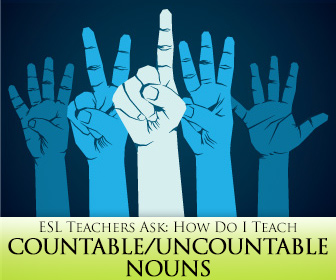I have ESL students who constantly say things like, “I have few time” or “I know much people in New York”. These types of mistakes, involving countables and uncountables are far too common. Is there a way to teach the differences between countable and uncountable nouns in a way that won’t confuse my students?*
There are mistakes ESL students typically make when they speak, and these are some of the most common. The difference between a little and a few, many and much, confuses them to no end. Sadly, ESL teachers can add to the confusion. We may understand the differences perfectly, but conveying them in a clear manner is a whole other thing. Here are some pointers for teaching, reviewing or practicing countable and uncountable nouns.

How to Teach Countable and Uncountable Nouns
-
1
The Basic Explanation
A lot of teachers make the mistake of saying that uncountable nouns are things we can’t count.A lot of teachers make the mistake of saying that uncountable nouns are things we can’t count, and while this is true of liquids like milk, water or juice, there are some uncountables you can actually count like money. So the basic explanation should be that you can add a number in front of countables, but you can’t do that to uncountables. While we can count the individual bills and coins, and say we have 10 dollars, we don’t say we have 10 monies.
-
2
Brainstorm Examples
Once they get this basic explanation, they should be able to brainstorm examples. Draw a line down the middle of the board to divide it into two halves. On one side write countable and on the other write uncountable. Students should have no trouble coming up with examples of countable nouns, but if they are in doubt remind them of things they can add a number to: Can we say five children? Then children is a countable noun. See how many uncountables they can come up with on their own. Then, call out nouns and have your class tell you if they’re countable or uncountable nouns. Be sure to add each to the right column.
-
3
Contrast
If water is uncountable what happens if we talk about glasses of water? Slices are countable while bread is uncountable. Brainstorm other ways to make uncountable nouns countable: glasses of juice; cups of teas; pieces of cake, etc… Note what happens to money; money is an uncountable noun and currencies are countable (dollars, pesos). The same happens with traffic and cars. Can they come up with other examples? (luggage vs. suitcases/bags; time vs. hours/minutes/seconds)
-
4
What if They’re Both?
There are nouns that can be both countable and uncountable, and students must understand the difference. Chicken is uncountable if it’s a food, but countable if it’s the animal. Some are a bit more confusing. Although coffee is technically uncountable, people often say they’ve had three coffees, because what they actually mean is cups of coffee, which are countable. The same happens with beer and beers; the second refers to individual bottles of beer and not the liquid. What happens if we say five meats? We’re talking about five different kinds of meat, like beef, pork, lamb, etc…not five pieces or slices of meat.
-
5
The Grammar Rules
Review some basic rules when using countables/uncountables. The first thing you should point out is the use of the article a. While it’s OK to say a chicken, when talking about the animal, you can’t say a chicken if you're talking about the food (if I say, I ate a chicken it sounds like I ate a whole one!) Other grammar to review includes the use of there is and there are, a few and a little, much and many, and some and any.
-
6
Practice
For practice, I recommend establishing a context and goal. Tell your class to imagine they have to go to the supermarket and need to make a shopping list. They must think about what they have in their refrigerator, pantry or kitchen. Ask students:
T: Do you have any chicken?
S1: I have some chicken.
T: Do you have any sodas?
S2: I have a few/a lot of sodas.
T: Do you have any milk?
S3: I have a little/a lot of milk.Have students ask each other. Have a restaurant role play where students ask the waiter about food items the restaurant has.
-
7
How Much or How Many?
Don’t forget to practice questions with how much and how many. This is when you can really tell they’ve “got it”. Tell them to imagine they work in a restaurant, and they’re checking to see what food supplies they have. One student is the restaurant manager/head chef while the rest are the kitchen staff who must answer the questions.
Manager: How many apples do we have?
Staff: We have a lot of apples.
Manager: How much milk do we have?
Staff: We a have a little milk. -
8
Games and Activities with Countable and Uncountable Nouns
The best way for students to fully grasp the differences between countable and uncountable nouns is through lots of practice, and there’s no better way to practice than through games. Play a card game or print these flashcards to create your own board game. Another great activity is to have students cut out countable and uncountable nouns from magazines to paste them in the right column.
Countable and uncountable nouns are certainly confusing, and you may try to make them less so.
But at the end of the day, it’s the amount of practice that makes a real difference. Remember that effective, timely corrections will also help them overcome these chronic mistakes.
P.S. If you enjoyed this article, please help spread it by clicking one of those sharing buttons below. And if you are interested in more, you should follow our Facebook page where we share more about creative, non-boring ways to teach English.







